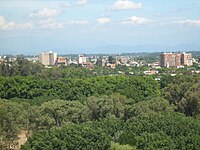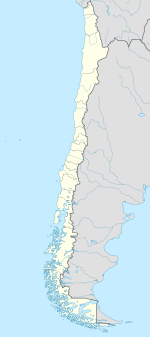San Agustin de Talca
| Talca | |||||
|---|---|---|---|---|---|
| City and Commune | |||||

Downtown as seen from Cerro La Virgen.
|
|||||
|
|||||
| Coordinates: 35°26′0″S 71°40′0″W / 35.43333°S 71.66667°WCoordinates: 35°26′0″S 71°40′0″W / 35.43333°S 71.66667°W | |||||
| Region | Maule Region | ||||
| Province | Talca Province | ||||
| Founded | May 12, 1742 | ||||
| Government | |||||
| • Type | Municipality | ||||
| • Alcalde | Juan Carlos Díaz Avendaño | ||||
| Area | |||||
| • Total | 231.5 km2 (89.4 sq mi) | ||||
| Elevation | 102 m (335 ft) | ||||
| Population (2015 Census) | |||||
| • Total | 233,339 | ||||
| • Density | 1,000/km2 (2,600/sq mi) | ||||
| Demonym(s) | Talquino | ||||
| Sex | |||||
| • Men | 111,796 | ||||
| • Women | 121,543 | ||||
| Time zone | CLT (UTC−4) | ||||
| • Summer (DST) | CLST (UTC−3) | ||||
| Postal code | 3460000 | ||||
| Area code(s) | 56 (country) + 71 (Talca Province) | ||||
| Climate | Csb | ||||
| Website | Official website (in Spanish) | ||||
Talca (Spanish pronunciation: [ˈtalka]) is a city and commune in Chile located about 255 km (158 mi) south of Santiago, and is the capital of both Talca Province and Maule Region (7th Region of Chile). As of the 2012 census, the city had a population of 201,142.
The city is an important economic center, with agricultural (wheat) and manufacturing activities, as well as wine production. It is also the location of the Universidad de Talca and the Catholic University of Maule, among others. The Catholic Church of Talca has held a prominent role in the history of Chile.
The inhabitants of Talca have a saying, Talca, Paris & London, born from a hat shop which had placed a ribbon stating that it had branches in Paris and London. The shop was owned by a French immigrant named Jean-Pierre Lagarde.
According to the 2002 census of the National Statistics Institute, Talca spans an area of 231.5 km2 (89 sq mi) and had, in that year, 201,797 inhabitants. Of these, in 2002, 193,755 (96%) lived in urban areas and 8,042 (4%) in rural areas. Today, the city has about 233,339 inhabitants (111,796 men and 121,543 women) according to the 2015 census. The population grew by 15.63% (31,542 persons) between the 2002 and 2015 censuses.
The city was founded in 1692 by Tomás Marín de Poveda and refounded as Villa San Agustín de Talca in 1742 by José Antonio Manso de Velasco. It was partially destroyed by the 1928 Talca earthquake and the 2010 Chile earthquake, being rebuilt both times. It sits near the epicenter of the 2010, magnitude 8.8 earthquake and suffered severe shaking causing the collapse of much of the historic town centre. The city played a role in Chile's independence. Here, Bernardo O'Higgins signed the Chilean independence declaration in 1818.
...
Wikipedia



